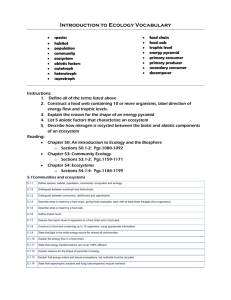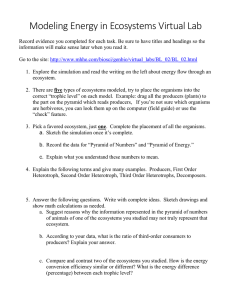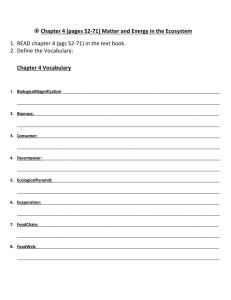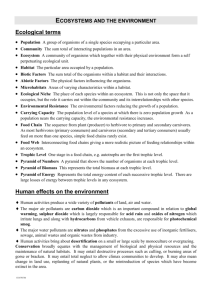Biology 16.2 Energy Flow in Ecosystems
advertisement
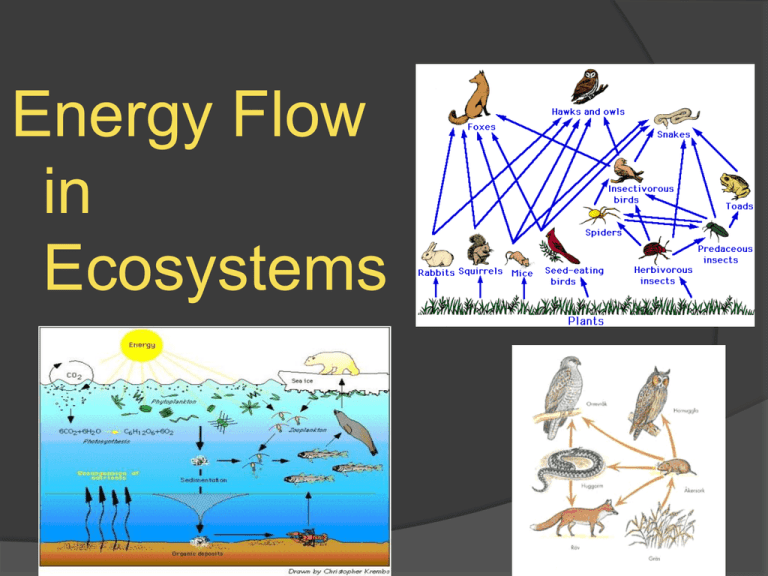
Energy Flow in Ecosystems Movement of Energy through Ecosystems Everything that organisms do in an ecosystem; running, breathing, burrowing, growing, requires energy. The flow of energy is the most important factor that controls what kind of organisms live in an ecosystem and how many organisms the ecosystem can support. Movement of Energy through Ecosystems Primary Energy Source Most life on Earth depends on photosynthetic organisms, which capture sunlight and convert it to chemical energy in organic molecules. These organic molecules are what we call food. The rate at which organic material is produced by photosynthetic organisms is called primary productivity. Primary productivity determines the amount of energy available in an ecosystem. Movement of Energy through Ecosystems Primary Energy Source Most organisms in an ecosystem can be thought of as chemical machines driven by the energy produced in photosynthesis. Organisms that first capture the energy are called producers and include plants, some kinds of bacteria, and algae. Movement of Energy through Ecosystems Primary Energy Source Producers make energy-storing molecules. All other organisms in an ecosystem are consumers. Consumers are those organisms that consume plants or other organisms to obtain their energy. Movement of Energy through Ecosystems Trophic Levels Ecologists study how energy moves through an ecosystem by assigning organisms in that ecosystem to a specific level called a trophic level. In the chart at right, energy moves from one trophic level to the next; from sunlight to producer to primary consumer and on down the chain. Movement of Energy through Ecosystems Trophic Levels The path of energy through the trophic levels of an ecosystem is called a food chain. The lowest trophic level of an ecosystem is occupied by the producers (plants, algae, bacteria) which take sunlight and convert it to food energy. Producers use the energy of the sun to build energy rich carbohydrates. Movement of Energy through Ecosystems Trophic Levels: Primary Consumers At the second trophic level we have herbivores. Herbivores are animals that eat plants or other primary producers. These organisms that consume producers are called primary consumers. Cows and horses, as well as caterpillars and ducks, field mice and moose; are all examples of primary consumers. Movement of Energy through Ecosystems Trophic Levels: Secondary Consumers A herbivore must be able to break down a plants molecules into useful energy. At the third trophic level we have secondary consumers. Secondary consumers are animals that eat other animals. These animals are called carnivores. In the diagram at right, the mouse is a primary consumer because it feeds off the producer. The snake is a secondary consumer because it feeds off the mouse. Movement of Energy through Ecosystems Trophic Levels: Secondary Consumers At the third trophic level (secondary consumers), animals such as tigers, wolves, and snakes are carnivores; consuming other animals. Some animals, such as bears, eat both plants and other animals. They are both herbivores and carnivores together, called an omnivore. Movement of Energy through Ecosystems Trophic Levels: decomposers In every ecosystem there is a special class of consumers called detritivores. Detritivores are organisms which obtain their energy from organic wastes and dead bodies produced at all trophic levels. They are the decomposers of the food chain; assisting in breaking down dead organisms and helping return their nutrients to the Earth. These decomposers include worms, bacteria, fungi and some insects. Movement of Energy through Ecosystems Trophic Levels: decomposers Decomposition of bodies and wastes releases nutrients back into the environment to be recycled by other organisms. The recycled nutrients provide mineral nourishment for the producers in the food chain. Movement of Energy through Ecosystems Trophic Levels: Tertiary consumers Many ecosystems contain a fourth trophic level made up of carnivores that consume other carnivores called tertiary consumers. The hawk that eats a snake is a tertiary consumer unless a larger bird of prey eats the hawk. Very rarely do ecosystems contain more than 4 trophic levels. Food Webs In most ecosystems, energy does not simply follow one path on one level because organisms often feed at many different levels of a food chain. This creates a complicated interconnected group of food chains called a food web. In the diagram at right, the producers are the grass and plants and the rabbits, squirrels, mice birds and insects. The fox, hawk and snake are secondary consumers, eating the rabbits and squirrels. The fox, hawks and snakes are all also examples of tertiary consumers because they are the final stop on the food web. Only with their death and decay does their energy return to the system. Food Webs Look at the food web to the right. Which organisms in this chart are the producers taking their energy from sunlight? Which are the primary consumers that feed off the producers plants? Which are the secondary producers that feed off the primary consumers? Which of these organisms are tertiary consumers, being the final steps in their food chains? Loss of Energy in a Food Chain: A deer browsing on grass is taking in potential energy. Potential energy is stored in the chemical bonds within the molecules of the leaves. Some of this energy is transformed to other forms of energy, such as fat in an organism. Some of this energy aids the deer in life processes; such as running and breathing. Much of the energy is dispersed into the environment as body heat given off by the deer. Energy Loss During every transfer of energy in an ecosystem, energy is lost as heat. Although heat can be used to do work (as in a steam engine), it is generally not a useful source of energy in biological systems. Thus, the amount of useful energy decreases as energy passes through the levels of an ecosystem. This loss of energy limits the number of trophic levels an ecosystem can support. Energy Loss in a food chain When a plant harvests energy from sunlight, photosynthesis captures only about 1% of the energy available to the leaves. When a herbivore consumes a plant, using the plants molecules to make food molecules within the herbivore, only about 10% of the energy in the plant ends up in the herbivores molecules. 90% is lost in the process. When a carnivore consumes the herbivore, again only 10% of the energy of the herbivore gets passed along. Again, 90% is lost. Energy Loss in a food chain At each trophic level, the energy stored by the organisms in a level is about 1/10th of the energy stored by the previous level. Ecologists often illustrate the flow of energy through ecosystems with an energy pyramid. An energy pyramid is a diagram in which each trophic level is represented by a block, and the blocks are stacked on top of each other, with the lowest trophic level as the base of the pyramid. Energy pyramid Energy Loss in a food chain The organisms at higher feeding levels of an energy pyramid do not necessarily require less energy to live than organisms at lower levels. Since so much energy is lost at each level, the amount of energy in the producer level limits the number of consumers the ecosystem can support. As a result, there usually are few organisms at the highest level in a food web and increasingly more organisms as you move down the energy pyramid to successively lower feeding levels. Energy pyramid


